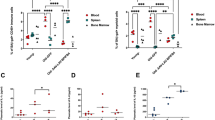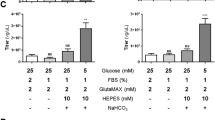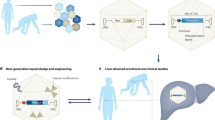Abstract
Helper-dependent adenoviral (HD-Ad) vectors have great potential for gene therapy applications; however, their administration induces acute toxicity that impairs safe clinical applications. We previously observed that PEGylation of HD-Ad vectors strongly reduces the acute response in murine and primate models. To evaluate whether PEGylated HD-Ad vectors combine reduced toxicity with the correction of pathological phenotypes, we administered an HD-Ad vector expressing the human apolipoprotein A-I (hApoA-I) to low-density lipoprotein (LDL)-receptor-deficient mice (a model for familial hypercholesterolemia) fed a high-cholesterol diet. Mice were treated with high doses of HD-Ad-expressing apo A-I or its PEGylated version. Twelve weeks later, LDL levels were lower and high-density lipoprotein (HDL) levels higher in mice treated with either of the vectors than in untreated mice. After terminal killing, the areas of atherosclerotic plaques were much smaller in the vector-treated mice than in the control animals. Moreover, the increase in pro-inflammatory cytokines was lower and consequently the toxicity profile better in mice treated with PEGylated vector than in mice treated with the unmodified vector. This finding indicates that the reduction in toxicity resulting from PEGylation of HD-Ad vectors does not impair the correction of pathological phenotypes. It also supports the clinical potential of these vectors for the correction of genetic diseases.
This is a preview of subscription content, access via your institution
Access options
Subscribe to this journal
Receive 12 print issues and online access
$259.00 per year
only $21.58 per issue
Buy this article
- Purchase on Springer Link
- Instant access to full article PDF
Prices may be subject to local taxes which are calculated during checkout




Similar content being viewed by others
Change history
05 December 2013
This article has been corrected since online publication and a corrigendum is also printed in this issue
References
Fitzgerald ML, Mujawar Z, Tamehiro N . ABC transporters, atherosclerosis and inflammation. Atherosclerosis 2010; 211: 361–370.
Yusuf S, Hawken S, Ounpuu S, Dans T, Avezum A, Lanas F et al. Effect of potentially modifiable risk factors associated with myocardial infarction in 52 countries (the INTERHEART study): case-control study. Lancet 2004; 364: 937–952.
Civeira F . Guidelines for the diagnosis and management of heterozygous familial hypercholesterolemia. Atherosclerosis 2004; 173: 55–68.
Rashid S, Marcil M, Ruel I, Genest J . Identification of a novel human cellular HDL biosynthesis defect. Eur Heart J 2009; 30: 2204–2212.
Oram JF, Vaughan AM . ATP-Binding cassette cholesterol transporters and cardiovascular disease. Circ Res 2006; 99: 1031–1043.
Lewis GF, Rader DJ . New insights into the regulation of HDL metabolism and reverse cholesterol transport. Circ Res 2005; 96: 1221–1232.
Robinson JG, Bakris G, Torner J, Stone NJ, Wallace R . Is it time for a cardiovascular primary prevention trial in the elderly? Stroke 2007; 38: 441–450.
Assmann G, Gotto AM Jr . HDL cholesterol and protective factors in atherosclerosis. Circulation 2004; 109 (23 Suppl 1): III8–14.
Van Craeyveld E, Gordts S, Jacobs F, De Geest B . Gene therapy to improve high-density lipoprotein metabolism and function. Curr Pharm Des 2010; 16: 1531–1544.
Van Lenten BJ, Wagner AC, Anantharamaiah GM, Navab M, Reddy ST, Buga GM et al. Apolipoprotein A-I mimetic peptides. Curr Atheroscler Rep 2009; 11: 52–57.
Harris JD, Evans V, Owen JS . ApoE gene therapy to treat hyperlipidemia and atherosclerosis. Curr Opin Mol Ther 2006; 8: 275–287.
De Geest B, Van Linthout S, Collen D . Sustained expression of human apo A-I following adenoviral gene transfer in mice. Gene Therapy 2001; 8: 121–127.
Pastore L, Belalcazar LM, Oka K, Cela R, Lee B, Chan L et al. Helper-dependent adenoviral vector-mediated long-term expression of human apolipoprotein A-I reduces atherosclerosis in apo E-deficient mice. Gene 2004; 327: 153–160.
Kassim SH, Wilson JM, Rader DJ . Gene therapy for dyslipidemia: a review of gene replacement and gene inhibition strategies. Clin Lipidol 2010; 5: 793–809.
Toietta G, Mane VP, Norona WS, Finegold MJ, Ng P, McDonagh AF et al. Lifelong elimination of hyperbilirubinemia in the Gunn rat with a single injection of helper-dependent adenoviral vector. Proc Natl Acad Sci USA 2005; 102: 3930–3935.
Oka K, Pastore L, Kim IH, Merched A, Nomura S, Lee HJ et al. Long-term stable correction of low-density lipoprotein receptor-deficient mice with a helper-dependent adenoviral vector expressing the very low-density lipoprotein receptor. Circulation 2001; 103: 1274–1281.
Belalcazar LM, Merched A, Carr B, Oka K, Chen KH, Pastore L et al. Long-term stable expression of human apolipoprotein A-I mediated by helper-dependent adenovirus gene transfer inhibits atherosclerosis progression and remodels atherosclerotic plaques in a mouse model of familial hypercholesterolemia. Circulation 2003; 107: 2726–2732.
Cerreto M, Mehdawy B, Ombrone D, Nistico R, Ruoppolo M, Usiello A et al. Reversal of metabolic and neurological symptoms of phenylketonuric mice treated with a PAH containing helper-dependent adenoviral vector. Curr Gene Ther 2012; 12: 48–56.
Morral N, Parks RJ, Zhou H, Langston C, Schiedner G, Quinones J et al. High doses of a helper-dependent adenoviral vector yield supraphysiological levels of alpha1-antitrypsin with negligible toxicity. Hum Gene Ther 1998; 9: 2709–2716.
Schiedner G, Morral N, Parks RJ, Wu Y, Koopmans SC, Langston C et al. Genomic DNA transfer with a high-capacity adenovirus vector results in improved in vivo gene expression and decreased toxicity. Nat Genet 1998; 18: 180–183.
Brunetti-Pierri N, Palmer DJ, Beaudet AL, Carey KD, Finegold M, Ng P . Acute toxicity after high-dose systemic injection of helper-dependent adenoviral vectors into nonhuman primates. Hum Gene Ther 2004; 15: 35–46.
Muruve DA . The innate immune response to adenovirus vectors. Hum Gene Ther 2004; 15: 1157–1166.
Raper SE, Chirmule N, Lee FS, Wivel NA, Bagg A, Gao GP et al. Fatal systemic inflammatory response syndrome in a ornithine transcarbamylase deficient patient following adenoviral gene transfer. Mol Genet Metab 2003; 80: 148–158.
Appledorn DM, Patial S, McBride A, Godbehere S, Van Rooijen N, Parameswaran N et al. Adenovirus vector-induced innate inflammatory mediators, MAPK signaling, as well as adaptive immune responses are dependent upon both TLR2 and TLR9 in vivo. J Immunol 2008; 181: 2134–2144.
Cerullo V, Seiler MP, Mane V, Brunetti-Pierri N, Clarke C, Bertin TK et al. Toll-like receptor 9 triggers an innate immune response to helper-dependent adenoviral vectors. Mol Ther 2007; 15: 378–385.
Seregin SS, Appledorn DM, McBride AJ, Schuldt NJ, Aldhamen YA, Voss T et al. Transient pretreatment with glucocorticoid ablates innate toxicity of systemically delivered adenoviral vectors without reducing efficacy. Mol Ther 2009; 17: 685–696.
Mane VP, Toietta G, McCormack WM, Conde I, Clarke C, Palmer D et al. Modulation of TNFalpha, a determinant of acute toxicity associated with systemic delivery of first-generation and helper-dependent adenoviral vectors. Gene Therapy 2006; 13: 1272–1280.
Croyle MA, Le HT, Linse KD, Cerullo V, Toietta G, Beaudet A et al. PEGylated helper-dependent adenoviral vectors: highly efficient vectors with an enhanced safety profile. Gene Therapy 2005; 12: 579–587.
Wonganan P, Clemens CC, Brasky K, Pastore L, Croyle MA . Species differences in the pharmacology and toxicology of PEGylated helper-dependent adenovirus. Mol Pharm 2011; 8: 78–92.
Alemany R, Suzuki K, Curiel DT . Blood clearance rates of adenovirus type 5 in mice. J Gen Virol 2000; 81 (Pt 11): 2605–2609.
Prill JM, Espenlaub S, Samen U, Engler T, Schmidt E, Vetrini F et al. Modifications of adenovirus hexon allow for either hepatocyte detargeting or targeting with potential evasion from Kupffer cells. Mol Ther 2011; 19: 83–92.
Hofherr SE, Shashkova EV, Weaver EA, Khare R, Barry MA . Modification of adenoviral vectors with polyethylene glycol modulates in vivo tissue tropism and gene expression. Mol Ther 2008; 16: 1276–1282.
Weaver EA, Barry MA . Effects of shielding adenoviral vectors with polyethylene glycol on vector-specific and vaccine-mediated immune responses. Hum Gene Ther 2008; 19: 1369–1382.
Weaver EA, Nehete PN, Buchl SS, Senac JS, Palmer D, Ng P et al. Comparison of replication-competent, first generation, and helper-dependent adenoviral vaccines. PLoS One 2009; 4: e5059.
Hofherr SE, Senac JS, Chen CY, Palmer DJ, Ng P, Barry MA . Short-term rescue of neonatal lethality in a mouse model of propionic acidemia by gene therapy. Hum Gene Ther 2009; 20: 169–180.
Weaver EA, Chen CY, May SM, Barry ME, Barry MA . Comparison of adenoviruses as oncolytics and cancer vaccines in an immunocompetent B cell lymphoma model. Hum Gene Ther 2011; 22: 1095–1100.
Ishibashi S, Brown MS, Goldstein JL, Gerard RD, Hammer RE, Herz J . Hypercholesterolemia in low density lipoprotein receptor knockout mice and its reversal by adenovirus-mediated gene delivery. J Clin Invest 1993; 92: 883–893.
Tangirala RK, Rubin EM, Palinski W . Quantitation of atherosclerosis in murine models: correlation between lesions in the aortic origin and in the entire aorta, and differences in the extent of lesions between sexes in LDL receptor-deficient and apolipoprotein E-deficient mice. J Lipid Res 1995; 36: 2320–2328.
Benihoud K, Esselin S, Descamps D, Jullienne B, Salone B, Bobe P et al. Respective roles of TNF-alpha and IL-6 in the immune response-elicited by adenovirus-mediated gene transfer in mice. Gene Therapy 2007; 14: 533–544.
Aldhamen YA, Seregin SS, Amalfitano A . Immune recognition of gene transfer vectors: focus on adenovirus as a paradigm. Front Immunol 2011; 2: 40.
Appledorn DM, Aldhamen YA, Depas W, Seregin SS, Liu CJ, Schuldt N et al. A new adenovirus based vaccine vector expressing an Eimeria tenella derived TLR agonist improves cellular immune responses to an antigenic target. PLoS One 2010; 5: e9579.
Hartman ZC, Kiang A, Everett RS, Serra D, Yang XY, Clay TM et al. Adenovirus infection triggers a rapid, MyD88-regulated transcriptome response critical to acute-phase and adaptive immune responses in vivo. J Virol 2007; 81: 1796–1812.
Brunetti-Pierri N, Liou A, Patel P, Palmer D, Grove N, Finegold M et al. Balloon catheter delivery of helper-dependent adenoviral vector results in sustained, therapeutic hFIX expression in rhesus macaques. Mol Ther 2012; 20: 1863–1870.
Brunetti-Pierri N, Ng T, Iannitti DA, Palmer DJ, Beaudet AL, Finegold MJ et al. Improved hepatic transduction, reduced systemic vector dissemination, and long-term transgene expression by delivering helper-dependent adenoviral vectors into the surgically isolated liver of nonhuman primates. Hum Gene Ther 2006; 17: 391–404.
Brunetti-Pierri N, Clarke C, Mane V, Palmer DJ, Lanpher B, Sun Q et al. Phenotypic correction of ornithine transcarbamylase deficiency using low dose helper-dependent adenoviral vectors. J Gene Med 2008; 10: 890–896.
Toietta G, Pastore L, Cerullo V, Finegold M, Beaudet AL, Lee B . Generation of helper-dependent adenoviral vectors by homologous recombination. Mol Ther 2002; 5: 204–210.
Zhou H, Pastore L, Beaudet AL . Helper-dependent adenoviral vectors. Methods Enzymol 2002; 346: 177–198.
Palmer D, Ng P . Improved system for helper-dependent adenoviral vector production. Mol Ther 2003; 8: 846–852.
Bolin LM, Zhaung A, Strychkarska-Orczyk I, Nelson E, Huang I, Malit M et al. Differential inflammatory activation of IL-6 (-/-) astrocytes. Cytokine 2005; 30: 47–55.
Acknowledgements
This work was supported by the Telethon grant GGP04039, and from MIUR, project PRIN protocol number 2004069479_004. We thank Jean Ann Gilder (Scientific Communication srl, Naples, Italy) for revising and editing the text.
Author information
Authors and Affiliations
Corresponding author
Ethics declarations
Competing interests
The authors declare no conflict of interest.
Rights and permissions
About this article
Cite this article
Leggiero, E., Astone, D., Cerullo, V. et al. PEGylated helper-dependent adenoviral vector expressing human Apo A-I for gene therapy in LDLR-deficient mice. Gene Ther 20, 1124–1130 (2013). https://doi.org/10.1038/gt.2013.38
Received:
Revised:
Accepted:
Published:
Issue Date:
DOI: https://doi.org/10.1038/gt.2013.38
Keywords
This article is cited by
-
Helper-dependent adenovirus-mediated gene transfer of a secreted LDL receptor/transferrin chimeric protein reduces aortic atherosclerosis in LDL receptor-deficient mice
Gene Therapy (2019)
-
Gene therapy with helper-dependent adenoviral vectors: lessons from studies in large animal models
Virus Genes (2017)



